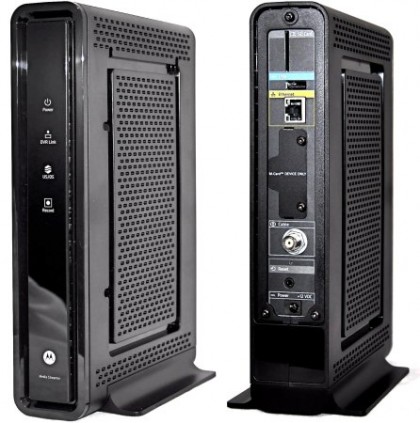
Motorola is finally taking their placeshifting technology beyond the labs. What was once known as the MCUBE and demo-ed as the Motorola Media Mover at the 2009 Cable Show, is nearly ready for it’s closeup. Unfortunately, the once sleek device, clocking in at cellphone dimensions (see below), has been reborn within a full fledged CableCARD-toting enclosure. Whereas the Media Mover was designed to hang off a cable set-top box via USB, the new Televation announced at the 2011 Cable Show, is a set-top box:
Televation employs a 1GHz digital tuner and CableCard to access broadcast TV channels directly from a coax outlet. The device has a high-performance transcoder that translates programming in real-time from MPEG-2 to MPEG-4, as well as changing resolution and bit rate to match the capabilities of the consumer’s viewing device while maintaining excellent picture quality. The device has an Ethernet jack to plug directly into the home Wi-Fi router so the TV show can be wirelessly streamed over IP to any device connected to the home network.
While the placeshifting device was designed in collaboration with Comcast, there’s no word on potential availability or rental fee. More importantly, to presumably steer clear of licensing issues, Televation is limited to in-home video streaming. (In fact, the press release emphasizes the CableLabs-approved IPRM-HN content protection.) So, while you may posses an Android or iOS device, you’d only be viewing Comcast programming from within range of your wireless router. Compared to the worldwide liberation provided by an agnostic Slingbox or Vulkano placeshifting device.

With all the various mobile apps and TV Anywhere initiatives, combined with local placeshifting marketing challenges, I doubt this product ever ends up in customer homes – Comcast or otherwise.
The only way I see it sticking around is in an altered form if the FCC were to force an Allvid like solution. Really, this just shows that Allvid can be done… Same holds for the Premiere Q/Preview combo. Same holds for DirecTV’s product… And Verizon’s… and…
These companies coming out with this stuff shows that the market wants it (or at least the producers think it is wanted), but we will be stuck with each provider and each manufacturer using a different technology. We will forever be stuck with our TVs being little more than a monitor and numerous add-ons in order to get the content we are already paying for.
What’s up with Dave doing the Motorola coverage? ;)
Yeah, this smells of AllVid. Not a bad solution given what the cable companies are asking for, but it’s the tech inside that’s valuable rather than the box itself. I watched Motorola’s IPRM for years, so I’m pleased to see it getting some traction. The real-time transcoding is nice, as is the 1 GHz tuner for cable plants that can make use of it. As for the in-home-only streaming, well that’s to be expected. And mostly it’s irrelevant given the straight-up streaming apps becoming available.
“Yeah, this smells of AllVid.”
Consider me confused. How does a CableCARD slingbox smell of AllVid? I know we all like to use “AllVid” to mean “everything we want from teevee that we’re not currently getting”, but…
Isn’t AllVid about rules of the road for IPTV?
Isn’t it just rather simply…
AllVid : IPTV :: CableCARD : Multicasting?
CableCARD could be used within an AllVid-esque solution… it’s the separable security technology for authentication/licensing and doesn’t necessarily imply or exclude other technologies related to broadcast/transmission or content security. In fact, this box is a gateway that securely streams around the house. Which does indeed conceptually sound like AllVid. What if it instead streamed to and was controlled by a TiVo endpoint or similar rather than a smartphone.
I’m an entry-level student of AllVid, which is why it often confuses me.
Like you Dave, I doubt this will get any traction at all with MSOs. Motorola clearly wants to add value to their STBs to avoid being comoditized but the MSOs would rather STB vendors were commoditized. Also, they want to roll out iPad support without requiring each user to install a new STB. So instead they are doing the iPad serving from central servers rather than having local transcoding. Which certainly makes more sense if you’re going to support this outside the home–it puts less stress on the MSO’s network too. Of course inside the home you could do this without using any MSO bandwidth if you had this Motorola device installed, but that’s a pretty limited use case.
IF AllVid were to be defined such that something like this could be a gateway device into the home then maybe it would have a shot. But otherwise I doubt it will see any uptake.